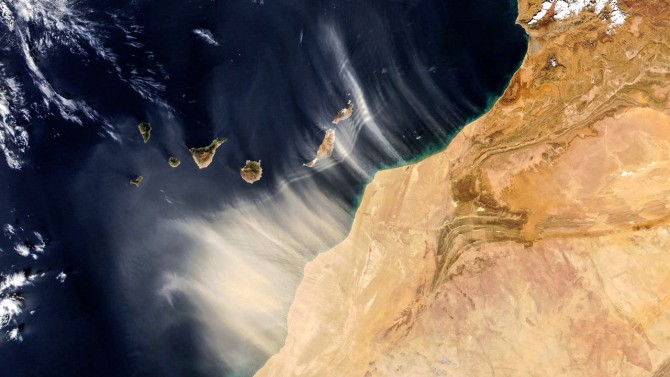NASA’s Earth Surface Mineral Dust Source Investigation mission will comprehensively measure the mineral composition of Earth’s mineral dust source regions to help scientists understand how dust particles carried by wind heat or cool our planet as they move through the atmosphere.
June launch for NASA-Cornell tool to view dust from space
By Blaine Friedlander
Scientists on Earth soon will see our planet’s atmospheric dust sources in high-resolution, as a new state-of-the-art imaging spectrometer – developed by NASA’s Jet Propulsion Laboratory (JPL) and Cornell – aims to survey the land surface from 250 miles above us on the orbiting International Space Station.
The instrument’s launch aboard a SpaceX Dragon re-supply mission to the ISS is scheduled for June 7, from the Kennedy Space Center in Cape Canaveral, Florida.
Scientists want to better understand how atmospheric dust contributes to the heating or cooling of the Earth.
“We’re trying to characterize the dust particulates that are blown from the surface into the atmosphere,” said Natalie Mahowald, the Irving Porter Church Professor in Engineering, who serves as the mission’s deputy principal investigator. “One of the biggest uncertainties in the climate system comes from aerosols, and dust aerosols are both important aerosols for climate change, and desert dust can change in response to climate change.”
“These aerosols — or dust – can be small or big, they can be lighter or darker, as all these different things are spatially heterogeneous,” she said. “They’re just really complicated.”
The imaging spectrometer is the science instrument for the Earth Surface Mineral Dust Source Investigation mission – known by the acronym EMIT – and it will measure the composition of minerals from Earth’s deserts that typically become airborne atmospheric dust. The project was selected from a group of proposals submitted in 2018 under NASA’s Earth Venture Instrument initiative.
There are many varieties of atmospheric dust. Those that contain iron oxides (rust) have dark hues that can warm the atmosphere. Conversely, clay or carbonate dust reflects sunlight and can cool the atmosphere. The instrument – which scans a 50-mile swath – will measure light in visible and infrared wavelengths, acquiring more than 1.6 gigabits of data each second to map mineral composition on Earth’s surface. The mission expects to gain more than 1 billion usable spectroscopic measurements.
“Different kinds of dust have different properties – they’re acidic, they’re basic, they’re light-colored, they’re dark – that determine how the particles interact with Earth’s atmosphere, as well as its land, water and ecosystems,” said Robert O. Green, EMIT’s principal investigator and JPL senior research scientist. “Within a year after launch, we’ll be on track to map the world’s dust-source regions and understand how dust heats and cools the planet, as well as how that might change under future climate scenarios.”
At the project start, the mission was informed by a paper on the impact of desert dust on the atmosphere; Mahowald credits Rachel Scanza M.S. ’14, Ph.D. ’16, who led the 2015 research, “Modeling Dust as Component Minerals in the Community Atmosphere Model: Development of Framework and Impact on Radiative Forcing,” published in Atmospheric Chemistry and Physics. That work simulated and modeled dust radiative forcing at the global scale, and it was funded by the National Science Foundation and the U.S. Department of Energy.
“Normally, in climate models, we just assume that desert dust particles are the average color of the ground,” said Mahowald, a faculty fellow at the Cornell Atkinson Center for Sustainability. “Rachel speciated the atmospheric dust and separated it into different kinds of minerals based on available data sets she found in the literature. But this data was based on limited observations from the United Nations’ Food and Agricultural Organization.”
Originally intended for agricultural purposes, Mahowald said that Scanza’s research showed that “while we didn’t have very many observations, the color of the soil and the mineralogy mattered quite a bit.”
Mahowald said that the new high-resolution data set for examining mineral dust source composition from EMIT will be comprehensive. “Remote sensing is the way to get coverage everywhere,” she said. “We’ll have better estimates of the dust composition and radiative forcing, to know whether these dust aerosols are warming or cooling our atmosphere.”
Media Contact
Get Cornell news delivered right to your inbox.
Subscribe

